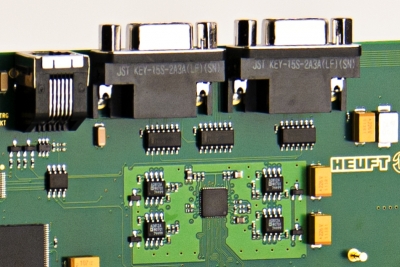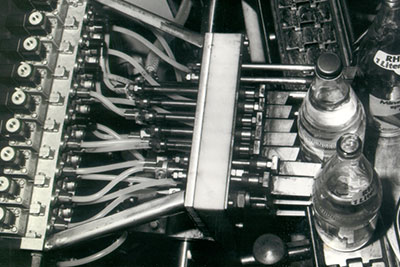Artificial intelligence with brains
Artificial intelligence (AI), machine learning, deep learning: euphonious buzzwords like these are currently on everyone‘s lips. However these "future technologies" are not "brand new" for HEUFT. The "future" already began here almost ten years ago. Where, how and for what purpose the technology leader already uses AI, what possibilities and limits machine learning and deep learning have in this context and whether big data alone is really sufficient are clarified by HEUFT Development Manager Dr Wolfgang Polster and Dr Thomas Jahnen, the Managing Director responsible for Technical Sales, in a double interview.
AI and Deep Learning: are they one and the same?
Dr. Thomas Jahnen: "AI and deep learning are often summarised in general terms. In fact deep learning only describes a part in which a neural network without prior knowledge 'learns' from a lot of data over time that some data patterns are conspicuous and should be regarded as errors – a special method of machine learning. And machine learning is in turn just one of several techniques of artificial intelligence."
Therefore human intelligence is not in demand at all these days?
Dr Wolfgang Polster: "The principles of deep learning, where a general network automatically adapts to the task by learning it, have generally been replaced by 'human intelligence' at HEUFT. Human people with a good technical understanding and knowledge of the process details in the concrete task area prepare meaningful evaluation structures. We have been achieving a high degree of detection reliability with a low false rejection rate with this for years now. In inspectors of the HEUFT SPECTRUM II generation we have relied on intelligent image filtering from the very beginning whereby 'human intelligence' was used to develop the correct filter structure. The result is a problem-specific evaluation process."
'Human intelligence'? What's supposed to be human about image filtering?
Dr Thomas Jahnen: "HEUFT launched the HEUFT reflexx² image processing system developed in-house in 2012. It is based on the experience gained with the first generation of the HEUFT reflexx technology which has been used since 1998 and enables the feature detection of objects by using very fast hardware co-processors. A targeted evaluation is then carried out in a multi-dimensional classification process. However, the structure of this evaluation is based on the experience of humans and the expertise they have acquired: Man knows that certain features belong to the production process. Therefore, he can quickly classify the 'good' objects based on a few exclusively good products. The machine then learns these objects in a multidimensional feature space."
Therefore machine learning receives human support. What are these objects which humans are simply better at evaluating? Which part does he take on and which part does the machine?
Dr. Wolfgang Polster: "The main task is carried out by a hardware coprocessor which extracts features from the images. It generates an object list of suspicious areas with up to 46 individual features from the image. Filter layers, predefined by people, are used for this purpose which are all run through one after the other. Teaching in several thousands images is not necessary at all due to this pre-structuring. A general neural network starts with the knowledge level of an infant and can be applied to any task. We start at the knowledge level of a university graduate with practical experience in empty bottle inspection. In both cases, the result is a highly complex filter structure for empty bottle inspection in the form of a network which is not adapted to the individual properties of the bottles examined. The abobe-mentioned multidimensional feature space is created from the object list in the next step. This is the basis for machine learning and AI. In it, the special properties of the bottles can be taughed in here."
Dr. Thomas Jahnen: "Containers with special structures such as embossings and alignment notches pass through the empty bottle inspector in any orientation. These objects are of course visible in the inspection image, but are clearly identified by the machine on the basis of feature classification and then receive the evaluation in the machine required by the human person. This makes a traceable representation of all objects present in the image at any time. Such objects can be re-evaluated without any time delay. Especially when introducing new products, it can be useful to be able to switch valuation details on and off at short notice. Of course, there are also features which contribute to a different appearance of the product. For example, drops of water on empty bottles after the washing process can be found in different but unpredictable positions. Here too the HEUFT technology has succeeded for years in excluding the influence of water drops on the inspection result without limiting the inspection performance by means of the classification described."

And the correct evaluation and classification of such harmless water drops is based on human experience?
Dr. Wolfgang Polster: "Yes, exactly. It is true that there are already predefined filters for taking interfering objects such as water droplets into acount. However, their properties were analyzed in advance by experts to determine a characteristic. This achieves a very good separation in the feature space between water drops and fault objects."
Dr. Thomas Jahnen: "For example intelligent filters support the differentiation between condensation without and scuffing with special structures. Specific technologies such as HEUFT’s patented rainbow illumination add additional parameters. This makes improved automatic decisions possible so that for example a transparent drop of water can be clearly differentiated on the basis of its light refraction from a transparent plastic object such as the fragment of a tablet blister in the bottle. This is because human experience teaches us that the rainbow in the drop is reflected in reverse drop, whereas the sequence of colors remains the same in the transparent blister piece . The search for 'inverted rainbows' thus forms the basis of the differentiation between harmless and critical objects. The prerequisite for this is therefore again 'human intelligence', i.e. human knowledge and human experience."
How does this affect detection reliability?
Dr. Thomas Jahnen: "A precise inspection is expected from the very first product when checking the quality with automatic inspection devices especially in the case of critical control points. The inspection results have to be reproducible and verifiable by humans. Only then is validation of the inspection device possible. Inspection results with detection accuracies significantly greater than 99 procent are expected at all times. Furthermore the clear inspection result has to be provided very quickly – there are frequently hardly 50 milliseconds per product available for determining the evaluation. The calculation processes have to be correspondingly fast and reliable. This is where this human pre-assessment of conspicuous data patterns helps. Therefore an abnormality can be 'learned' as a fault by means of deep learning. However, it often cannot be localized, quantified and evaluated more precisely."
And this is what it comes down to in order to only reject faulty containers?
Dr. Wolfgang Polster: "Correct. AI always requires the training of pre-classified good and bad objects. Non trained faults can pass through when detection rates of more than 99 per cent are required because not all types of bad objects can be trained in the course of this. And that is the worst-case scenario for a quality inspector. Achieving a lower false rejection rate at the expense of the detection rate is counterproductive. Therefore a very important definition is made right at the beginning: the entire feature space is defined as a bad bottle. In principle, no faults are taught in. Just good bottles are taught in and therefore only small areas of the space of multidimensional bubbles defined as good. This results in unknown objects always being classified as faults and rejected."
Is deep learning therefore not an issue for inspection technology at all?
Dr. Thomas Jahnen: "Of course the neural network technology makes a general improvement to the inspection performance possible together with the inspection evaluation. HEUFT has been using such processes since 2018 i.e. for filtering electronic noise. This further increases the image quality and thus the performance of the image evaluation. Further applications will follow. The positive experience with the intensively used machine learning is confirmation for HEUFT that the development process started years ago has to be pursued and even expanded."
Dr. Wolfgang Polster: "The use of deep learning always makes sense where structures are involved which can no longer be described in a generally valid way by humans. This type of AI is already in practical use here in the latest release of the HEUFT eXaminer II XOS full container inspector. Thus X-ray images are de-noised and cleared of artifacts before they undergo normal processing. For this the network was trained once with thousands of good images and optimised. However, classification is carried out aftrewards according to our proven structures."



